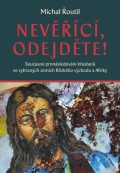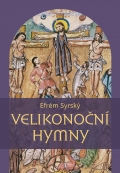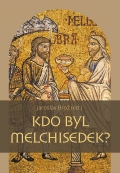Series Pro Oriente

The Calamity of Christians
The Extermination of the Armenians, Assyrians, and Greeks in the Ottoman Empire, 1914–1923
Michal Řoutil, Petra Košťálová, Petr Novák
The study The Calamity of Christians: The Extermination of the Armenians, Assyrians, and Greeks in the Ottoman Empire, 1914–1923 is one of the first academic attempts to address the massacres of Christians in the Ottoman Empire, which were perpetrated in 1914–1923. The book views the issue not only as the national tragedy of the Armenians but more comprehensively as an attempt to exterminate all local Christians, primarily Assyrians/Syriacs and Greeks.
The book consists of four main parts.
First part is divided into two chapters. First chapter examines the overall political and economic situation in the Ottoman Empire from the mid nineteenth century until 1914, focusing on political changes resulting from the Tanzîmât reforms, two edicts – Hatt-ı Şerif-î Gülhane and Hatt-ı Hümâyûn, the reign of Abdülhamit II, the Young Turk Revolution (July 1908), the Balkan Wars of 1911–1913, and entering of the Sublime Porte into the First World War.
The second chapter turns to Christian minorities living in the Ottoman Empire, such as Armenians, Assyrians/Syriacs, and Greeks (people of dhimmi status), discussing ecclesiastical and social structure of communities (millets), economic and political influence of these communities, and their relations with the authorities and the Muslim majority. Other issues addressed in this chapter include ecclesiastical and cultural relations with other European countries, Russia, and the USA, education and influence of European and American missionaries, ethnic and religious revival, the emergence of Churches in union with Rome as well as Protestant communities, etc. Special attention is given to the persecution of Christians, including the bloody Hamidian massacres (1894–1896), and the pogroms in the town of Adana and its vicinity (April 1909).
The second part of the book consists of three chapters directly discussing the tragic events of 1914–1923.
Frst chapter – “Medz Yeghern” (Great Calamity) – describes the genocide of the Armenians in the Ottoman Empire in 1915–1916. The authors focus on the gradual unfolding of events: the defence of the town of Van by the Armenian population (April–May, 1915), the arrest and deportation of the Armenian intellectuals on April 24, 1915 (“Red Sunday”), the arrest and execution of Armenian men, the adoption of the Tehcir Law on May 29, 1915, and the subsequent deportations of the innocent civilian population. The creation of Teşkilat-ı Mahsûsa which consisted of special force units of the Young Turk Government and was the main perpetrator of crimes, is also described. Deportations and execution of people are treated geographically, which means that the authors first analyze the situation in six Eastern Anatolian vilayets of the Ottoman Empire (Erzurum, Van, Bitlis, Diyarbekir, Harput/Mamuret ül-Aziz, Sivas), and only then go on to analyze the situation in all other provinces, including the major cities such as Constantinople and Smyrna.
The course, extent, and overwhelming impact of the deportations depicted in this account clearly demonstrate the effort to destroy the entire Armenian community. This conclusion is confirmed by the evidence of cable telegrams preserved in the Ottoman (Turkish) archives, diplomatic reports surviving in other countries (particularly, valuable documents from the archives in Germany – an ally of the Ottoman Empire at that time), missionary diaries, and eyewitness accounts.
Another issue discussed is the resistance of the Armenians to deportations and extermination. In addition to heroic struggle of the native population from the villages around Musa Dagh (July–September, 1915), and their salvation by French and British ships, the authors also show other acts of self-defense in the towns of Zeytun, Şebinkarahisar, Sasun, Urfa, Harput, Muş, and Yozgat.
This discussion proceeds to several subchapters dedicated to the so-called “second phase” of the genocide of the Armenians (followed by their elimiantion in the summer of 1916). This phase was mainly directed toward the remaining Armenian population which survived death marches and lived in transition and concentration camps in the Syrian Desert (with the centre in Deir ez-Zor). Particular attention is given to the fate of wives and children during the deportations (methods of killing, sexual violence, slavery, forced conversions to Islam, Turkification, etc.), as well as orphans and orphanages, and the humanitarian aid provided by the international communities (especially the American organization called The Near East Relief). The chapter entitled “Righteous Among the Nations” is devoted to those Ottoman people (Turks, Kurds, Yazidis, and Greeks), who resisted the state genocidal policy and risked their lives by rescuing Christians. Economic, political, and religious contexts of the genocide are also analyzed, as well as the world-wide response to these tragic events.
Chapter two – “Sayfo” (Sword, or [The Year of the] Sword) – deals with the “untold holocaust”, as it is sometimes called, of Assyrians/Syriacs in the last years of existence of the Sublime Porte. Being the members of various Syriac Churches and known by various names (Assyrians, Nestorians, Jacobites, Syriacs, Chaldeans, or Arameans), they suffered almost the same fate as the Armenians during this period. The central part of this section are the subchapters “Geography of Horror” and “Hecatombs and Οther Hecatombs,” which describes the acts of violence perpetrated to the Assyrians/Syriacs in Hakkari Mountains, Northern Mesopotamia (Diyarbekir, Mardin, Siirt, Tur Abdin), and in the Persian Azerbaijan (Urmia, Salmas, and its vicinity).
After realizing that the Ottoman Empire had no intent to protect the Assyrian Nestorian community against the Kurdish attacks and even considered the possibility of wiping out the Nestorian Christians, some leaders of that community decided to make an unprecedented step and declare war on the Ottomans (May, 1915). This was followed by several conflicts in which small Assyrian units fought on the side with the Russians and the British (mostly on the Ottoman-Persian border). Similar resistance was shown by the Syriacs who tried to resist the Kurdish and Ottoman forces. Thus, one subchapter looks closer at the places of resistance, namely, the town of Midyat and the villages of Ayn Wardo (Iwardo) and Azak.
The situation deteriorated once again after the murder of the Catholicos Mar Shimun XXI Benyamin (March, 1918) by the Kurdish chieftain Ismail Simko. The desperate situation in the summer of 1918 forced the Assyrians/Syriacs to leave the places where they lived for centuries and flee from Urmia to the British-controlled town of Hamadan. This section ends with the final accounts of the victims.
In the third chapter, “Sphagi” (Massacre), a comparative analysis shows that the persecution, extermination, and expulsion of the Greek population had direct connections with the Armenian genocide and the massacres of the Assyrians/Syriacs. Firstly, it is noted that the same Ottoman army commanders, officers and members of Teşkilat-ı Mahsûsa participated in several of the campaigns. Secondly, the operations were carried out according to the well-known dual-track mechanism that was also applied to the Armenians. Other similarities include the fact that men were assigned to the workers battalions (amele taburları) and when the deportations were taking place, the house owners were commanded to leave their homes for only a few hours (maximum several days) during which their property was confiscated and given to the Muslim refugees (muhâcir) to move in.
The evidence demonstrates that the acts of violence against the Greeks occurred mainly in Eastern Thrace, on the western coast of Asia Minor and in the southern coast of the Black Sea (Pontus). The next subchapter is focused on such issues as the situation after the First World War, Greek claims for some parts of the Ottoman territory, and the subsequent Greek-Turkish war (May, 1919 – October, 1922). This is followed by the analysis of the so-called “Disaster of Smyrna” on September 13, 1922, when a huge fire broke out four days after the Turkish forces regained control of the city. Consequently, the Greek and Armenian quarters were burnt to ashes (while the Muslim and Jewish quarters escaped the damage), resulting in tens of thousands of people being burnt alive. Soon after that the world also learned about the acts of violence perpetrated against the Greeks, although the true extent of the ethnic cleansing directed against them was revealed only after the ceasefire in 1918.
The third part of the book deals with the consequences of the tragic events which the Ottoman Christians faced in 1914–1923. The chronological line is traced almost to present day times.
As far as the Armenians are concerned (the first chapter), the authors focus primarily on the following topics: the “Armenian question” during the Ottoman expansion to the Southern Caucasus (1918), war tribunals in Constantinople (1919–1920), the act of revenge during the “Operation Nemesis,” including the murder of the Ottoman Minister of Interior Talât Paşa, “the architect of the genocide”, in Berlin in March, 1921, the Armenian-Turkish war (1920), the fate of the remaining Armenian population in the Ottoman Empire and Turkey in 1918–1945, the phenomenon of the “Hidden Armenians”, the destruction of the Christian cultural legacy (including the onomatocide), the current Armenian-Azerbaijani relations, the issue of recognition of the Armenian genocide, and several other topics. One specific issue that is thoroughly studied concerns the fundamental differences in the way these tragic events are understood and assessed by the Turkish and Armenian communities.
The post-war international situation surrounding the Assyrians/Syriacs and the solution of the so-called “Assyrian question” (which for many years was a part of the “Armenian question”, or broadly speaking, “Christian question” in the Near Eastern politics) constitutes the content of the second chapter. The years of hardships for Syriac Christians were definitely not over – they faced persecution and violence both in the territory of the newly established Republic of Turkey (the expulsion from the Hakkari Mountains in 1924–1925), and in the countries where they emigrated, especially Iraq (the Simele Massacre of 1933), resulting in massive wave of continued emigration and the formation of the worldwide Assyrian diaspora.
The third chapter describes the fate of Greek Orthodox Christians. The events of the First World War had a tragic impact on the Greeks in the Ottoman Empire and Turkey in following years. After the expulsions, deportations, and massacres, followed by the post-war bloody struggle, the Greek Orthodox faced a massive exchange of population between the Kingdom of Greece and the Ottoman Empire. Over 1.3 million Greeks, the last heirs of the Byzantine civilization, lost their homes, while, according to some data, there were 2400 original Greek ancient towns and villages in the territory which now is Turkey.
The fourth part of the book is entitled “Questions, Answers, and Wider Context”. It attempts at answering several questions, namely: To which extent was Germany involved in the Armenian genocide? To which extent did the Kurds participate in the massacres of their Christian neighbors? Are there parallels between the Armenian genocide and the Jewish Holocaust? How were the persecutions of the Ottoman Christians perceived by the Czech media in the Austro-Hungarian Empire, and (after 1918) in independent Czechoslovak Republic? The last three chapters offer reflections on the Armenian genocide and the persecution of the Assyrians/Syriacs and Greeks in literature, art, cinema, theater, and music.
The authors approach the issue exclusively from the cognitive standpoint rather than treating it politically. The conclusions offered in the book are supported by a rigorous study of various primary sources. The existing contemporary tensions regarding the “controversial” issues on different levels (scholarly, political, etc.) are considered to be not only an obstacle to a thorough study and understanding of the past events, but also a barrier to a proper analysis, recognition and adequate reception of the distant past.
| Language | Czech (English summary) |
|---|---|
| Hardcover | 744 |
| Issued | 2017 |
| ISBN | 978-80-7465-254-7 |
| Product dimensions | 165 x 235 mm |







